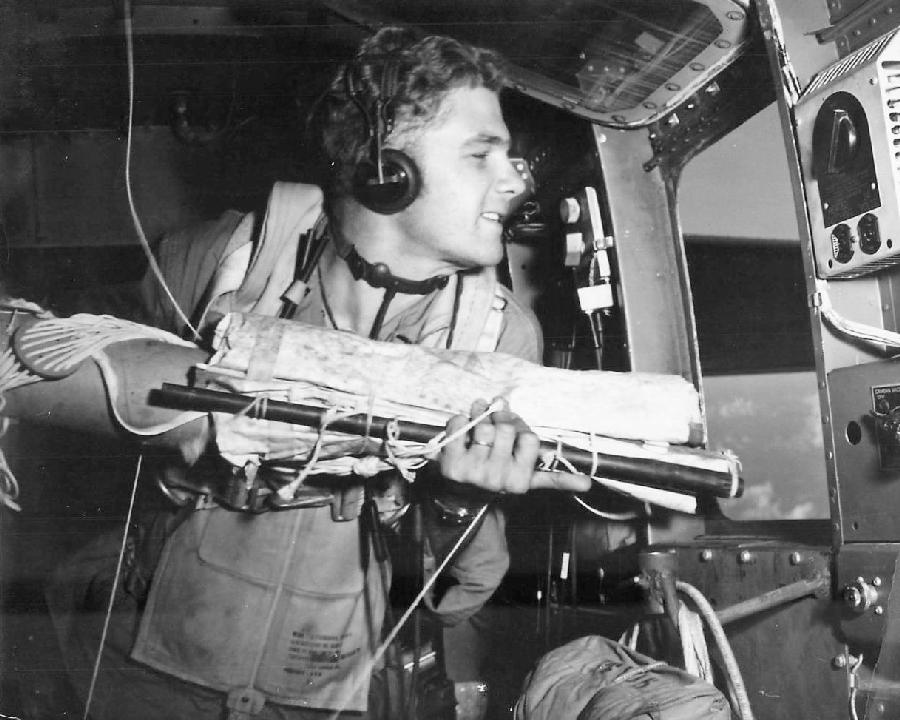
World War II South Pacific: Operation Cartwheel--Landings (1943-44)

Figure 1.--Each Cartwheel landing provided new air bases,, increasing the number of air craft that could be used to assault Rabaul. The Japanese were thus never sure when and frlom which direction the attcks would be coming. Here we scene at the end of Cartwheel (June 1944). The caption read, "Mission Completed: High over the Jap fortress of Rabaul, the anbitions of 35,000 Oklahoma City school children were realized when a croll, 65 feet long, bearing their signtutes, was dropped with a load of bomb on the Jap airfield at Rapopo. The students had each contributed ten cents to defray the cist of a Marine Corps Transport plne, named by them 'The Invasion Chief'. Mrine radio gunner Stff Sergeant W.W. Woolman, of 502 North Prouty Stret, Watoga, Okla, throws the scroll, attached to a parachute, out of aort in the B-25 bomber used tomake the delivery." Source: U.S. Mrinr Corps photo.
|
|
The Allied effort to take Rabaul on New Britain was code named Operation Cartwheel. General MacArhur launced Cartwheel (June 30, 1943). Cartwheel was a multi-pronged assault on Rabaul. The Americans began targetting the Japanese facilities at Rabaul once the Marines had secured the American beachead at Guadacanal, Rabaul became a prime target. General George C. Kenney's 5th U.S. Air Force using B25 bombers and other aircraft regularly attacked the Japanese instalations. American flyers by 1943 had high performance aircraft that outclassed the Japanese planes. These attacks escalated as the Americans drew rings around Rabaul by seizing more islands and constructing more air bases. The growing American forces launched a series of amphibious assaults on the islands surrounding Rabaul. The two key American commnders were General Douglas MacArthur and Admiral William 'Bull' Halsey. Gen. MacArthur lred the advance along the New Guinea coast. Adm. Halsey led the simultaneous Marine and army advance up the Solomon Islands chain. Every step up the Solomons ladder put additional pressue on the Japanese in Rabal. And islands to the east, north, and west of Rabal were also seized. MacArthur began Cartwheel with Australian troops who took Lae on the northern New Guinea coast (mid-September). U.S. forces then seized Saidor, opposite Cape Gloucester, on the westernmost tip of New Britain. While thiss the sane island where Rabaul was located. The terraine did not permit a direct attack. Every island provided new air bases from which to hammer Rabaul. Halsey’s forces attack Bougainville, the largest and westernmost island in the Solomon chain (October 1943). This was just 200 miles from Rabaul at the narrowest sea crossing. The Japanese 17th Army attempted to make a stand on the island and rushed 37,500 men there. They concentrated at Buin, near the island’s southern tip as well as small islets off the coast. New Zealand forces captured the Treasury Islands, south of Bougainville (October 27). U.S. Marines landed at Empress Augusta Bay, to the north (November 1). The U.S. Navy engaged dispersed Japanese defenders, sinking Japanese cruisers and a destroyer while the 5th Army Air Force bombed Japanese airfuelds and supported the Marine landings. Bougainville gave the Americans importnt new air bases to plaster Rabaul. Allied troops landed at Arawe, on the southwestern coast of New Britain (December 15). This effectively diverting Japanese focus from Cape Gloucester, on the northwestern coast. This assisted a major Allied landing there (December 26). The Allies sucessfully beat back a Japanese counterattack. The Allies suceded in capturing Cape Gloucester and its important irstrip (January 16, 1944). New Zealand soldiers seized the Green Islands, southeast of New Guinea (mid-February). The Americans invaded the Admiralty Islands (late-February). lThey then captured the Emirau Islands (March 20). Each of these islands meant new aurbases and an increasung creshendo of air assaults on Rabaul as well as resupply of Rabaul. Because the Japanese were never sure where the next blow would fall, found it difficult to counter the successive Allied blows. The two-pronged campaign suceeed in neutralize Rabaul (by March 1944). The Americans effectively cut off the once powerful bastion from both reinforcement and resupply.
CIH -- WW II

Navigate the CIH World War II Section:
[Return to Main World War II South Pacific Opration Crtwheel page]
[Return to Main World War II South Pacific naval campaign page]
[Return to Main World War II naval campaign page]
[Return to Main World War II page]
[About Us]
[Biographies]
[Campaigns]
[Children]
[Countries]
[Deciding factors]
[Diplomacy]
[Geo-political crisis]
[Economics]
[Home front]
[Intelligence]
[POWs]
[Resistance]
[Race]
[Refugees]
[Technology]
[Totalitarian powers]
[Bibliographies]
[Contributions]
[FAQs]
[Images]
[Links]
[Registration]
[Tools]
[Return to Main World War II page]
[Return to Main war essay page]
[Return to CIH Home page]
Created: 8:56 AM 11/16/2015
Last updated: 8:56 AM 11/16/2015



